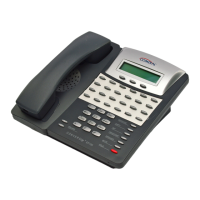
Do you have a question about the Comdial CONVERSip EP100 and is the answer not in the manual?
Specifies the intended users and their expected knowledge for this manual.
Refers to other documents for additional information.
Explains formatting conventions like italics and quotes used in the manual.
Explains the basic features and what they allow the user to do.
Details the functions of each button on the EP100 telephone.
Describes the status indicated by the LED lights on the EP100 display.
Provides guidance on adjusting the telephone's position for optimal use.
Instructions on how to adjust the LCD display contrast for better viewing.
Guides the user on selecting different ring tones for their telephone.
Explains how to adjust the loudness of the ringer, speaker, and handset.
Covers the basic procedures for answering and initiating calls.
Provides tips for effective use of the speakerphone feature.
Instructions on how to answer incoming calls from outside lines.
Details the process for answering internal calls from other stations.
Explains how to handle calls transferred for off-hour ringing.
Describes how to place calls on hold and retrieve them.
Covers methods for answering calls ringing at other stations.
Explains how to receive private voice announcements during a call.
How to block incoming voice announcements, including SOHVA.
How to view incoming call numbers before answering.
Procedures for dialing numbers on external telephone lines.
Instructions for initiating calls to other stations within the system.
How to use programmable buttons for speed dialing.
Covers redialing the last-dialed number and programming numbers.
How to camp on a busy station and receive an automatic callback.
Exploring options for camping on idle or busy stations.
How to send private voice announcements to busy stations.
How to place your telephone in a queue to await an idle line.
Setting up and managing conference calls with multiple parties.
Instructions for forwarding calls to another telephone.
How to forward calls to numbers outside the telephone system.
Placing calls on hold in park orbits for retrieval from any station.
Procedures for transferring calls, including screened and unscreened methods.
Details on specific transfer methods like hot and quick transfers.
How to set and receive system-supplied messages on the LCD.
Turning on message waiting lights and sending messages to other stations.
Using programmed buttons to send preselected messages to callers.
Storing station extension numbers for quick access and monitoring.
Storing and dialing frequently used numbers using one or two buttons.
Using access codes to program system features.
Creating feature access buttons using soft keys for easier operation.
Setting up to two reminder alerts for important events.
Programming buttons to send LCD messages to other telephones.
How to turn background music on or off and adjust volume.
Accessing outside lines through organized line groups.
Enabling or disabling the DND feature to block incoming calls.
Using the automatic redial feature for busy or unanswered numbers.
Sending call back and parked call messages to pagers.
Connecting external devices like headsets or recorders to the auxiliary jack.
Entering account codes for call record or billing purposes.
Searching an index of names to locate and dial station numbers.
Adjusting volume levels for ringer, speaker, handset, and headset.
Setting permanent loudness levels for future calls.
Displaying the function of each button on the telephone.
Managing telephone programming when moving to a new location.
Sending voice announcements through speakers or external paging units.